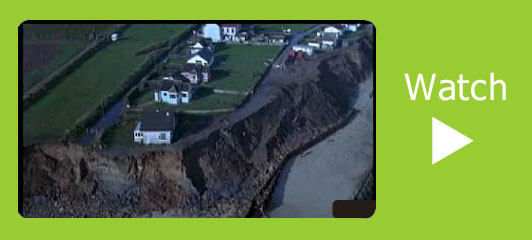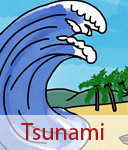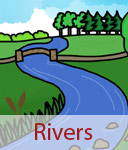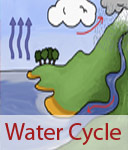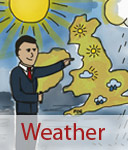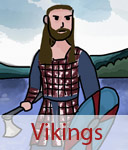
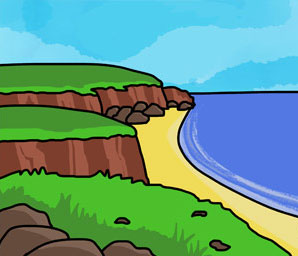
Coastlines for kids
Coastlines for kids learning in KS2 at Primary School. Homework help with coastlines and coastal erosion. Discover coastlines their features and what causes coastal erosion.
What are coasts?
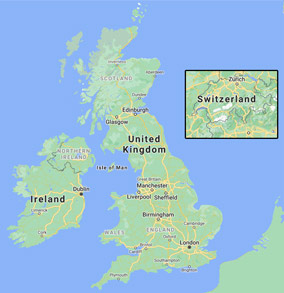 Coasts are when the land meets the sea. The coastlines of the United Kingdom is made up of cliffs, beaches and bays.
Coasts are when the land meets the sea. The coastlines of the United Kingdom is made up of cliffs, beaches and bays.
The UK is an island and is surrounded by water. It has 7,723 miles of coastline. Switzerland has no coastline as it's surrounded by other countries. It is known as a landlocked country.
There are two types of coastlines:
Rocky Coastlines - These have cliffs of different heights at the end of the land. The rock of the cliffs can be hard and soft. The soft rock will get worn away by the sea and can leave some dramatic coastlines.
Coastal Plains - Here the land gradually slopes towards the sea. They can have large sand dunes and mudflats. During storms, these are the first places to be flooded. This is because the land is low here and when the sea level rises the water covers the plains.
The UK have both rocky coastlines (eg. Dorset) and coastal plains (eg. Northumberland).

How are beaches formed?
Beaches are formed by the waves eroding the shoreline and cliffs. The large rocks fall off the land and get tossed around in the sea. The rocks are eroded and get smaller and smaller until the rocks become tiny particles, called sand. The tides deposit sand on the coast creating beaches. Some beaches have pebbles and not sand. This is because the sea hasn't broken down the rocks as much. The shape and size of a beach will depend on the wave strength and the type of sand or pebbles and the slope of the ocean floor. In some cases, beaches may also be formed by depositing sediment (materials broken down by erosion) carried by rivers and streams.
How are cliffs formed?
Cliffs are formed by erosion and weathering on rocks by the edge of the sea and land. The waves from the sea wear away softer rocks more easily than the harder rocks. This can create features along the coast like sea caves and arches.
What is the impact of humans on the coastline?
Human activity can have both positive and negative impacts on beaches and the coastline. Some ways that human activity can change a beach include:
- Coastal development: Construction of buildings, piers, jetties, and other structures can alter the natural flow of water and sediment, affecting the shape of the coastline. For example, seawalls can prevent the natural movement of sand, leading to beach erosion.
- Pollution: Human pollution, including plastic waste, oil spills, and sewage, can harm beach ecosystems and the wildlife that depend on them. Pollution can also make beaches unsafe for human use and reduce their beauty.
- Beach grooming: This is when the beach is changed to improve its appearance either by raking, grading, or adding sand. However, doing this too much can harm beach wildlife, including nesting areas for hermit crabs and other beach wildlife.
- Overuse: Heavy use of beaches by tourists or local residents can damage the beach environment. For example, trampling on dunes and other sensitive areas can harm vegetation and destabilize sand dunes, leading to erosion and loss of habitat for beach wildlife.
Overall, it is important to balance the human use of beaches with the need to look after their natural beauty and ecological value.
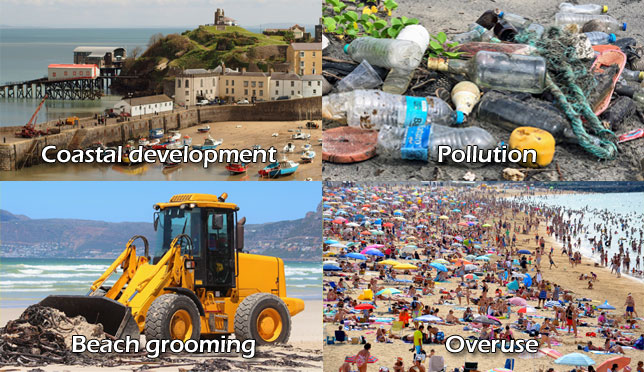
What causes coastal erosion?
Coastal erosion in the UK is caused by a combination of natural processes and human activity. Some of the main factors that cause to coastal erosion include:
- Wave action: Waves are a powerful force that can erode and reshape coastlines over time. In the UK, strong winds and storms can generate large waves that cause great amounts of erosion along the coastline.
- Climate change: Sea levels are rising globally due to climate change, which can increase the rate of coastal erosion in the UK. As sea levels rise, more of the coast becomes harmed by erosion, and storms and high tides can cause greater damage.
- Weathering: The UK's coastline is composed of a variety of rock types that are prone to weathering. Freeze-thaw cycles (rocks freeze in cold temperatures then warm up again), salt spray, and other forms of weathering can weaken the rocks and make them more likely to erode.
- Human activity: Human activity can also contribute to coastal erosion in the UK. Development, such as the construction of buildings and roads along the coast, can disrupt natural processes and alter the movement of sediment, leading to increased erosion. The digging out of sediment from the sea (dredging) to make harbours and other changes that alter the flow of water can also cause erosion.
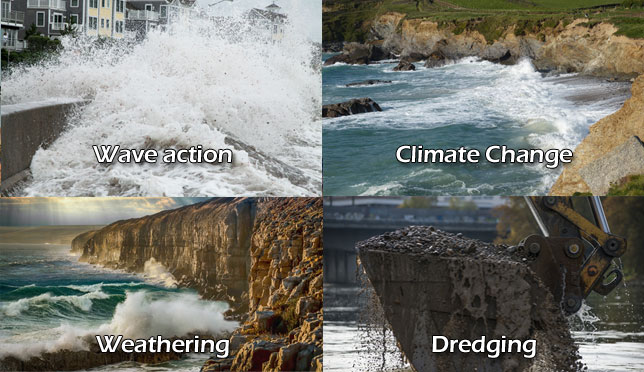
How can we stop coastal erosion?
Coastal erosion is a natural process that we cannot completely stop, but there are things that can be done to protect some of the worst areas of our coastlines. Some common things for preventing coastal erosion include:
- Beach nourishment: This is when sand or another sediment is added to the beach to widen the shoreline and beach. This gives pushes the sea away from the coastline as the beach becomes deeper. This is often done using dredged material or sediment from other areas away from the coastline.
- Coastal vegetation: Planting more vegetation such as grasses and shrubs can help stabilize sand dunes and other coastal areas, reducing the impact of erosion.
- Hard structures: Seawalls, groynes, and other hard structures can be made to protect the coastline from erosion. These structures can be expensive and have some negative impacts on the environment, so they are often used with other methods.
- Move away from the area: In some cases, it may be better to allow the coastline to erode naturally and eat away at the coastline. This can be a cheaper choice where erosion is happening too quickly and all other choices can not be put in or will not work. This means moving local people living on the coastline away from the area.
- Development restrictions: Rules can be applied to not allow the development of buildings or roads in areas where there is erosion. This will reduce the amount of erosion that happens in these areas.
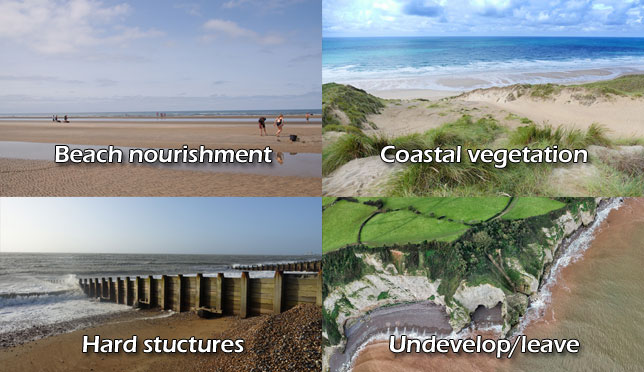
Follow Super Brainy Beans's board Coasts Day on Pinterest.
What causes tides?
Tides happen daily. Have you ever been to a beach when the tide comes in? The water seems to creep up the beach making the beach smaller. The tides are caused by the gravitational pull between the sun and the moon.
The Moon's gravity pulls water towards it, creating a bulge of water on the side of the Earth facing the Moon, and another bulge on the opposite side of the Earth. As the Earth rotates, these bulges of water cause the ocean level to rise and fall, creating high and low tides. The timing and height of the tides depend on the shape and how deep the ocean floor is and the location of the Moon.

